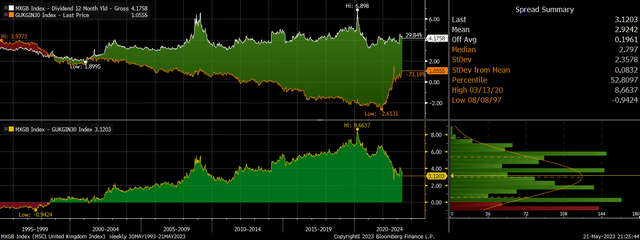EWU: Taking Some Profits On U.K. Stocks As Bonds Offer Better Value

Summary
- The surge in bond yields over the past year has substantially raised the opportunity cost of holding U.K. stocks, and I am taking some profits on my EWU positions.
- 30-year U.K. inflation-linked bonds now yield 1.1%, reducing the MSCI U.K.'s equity risk premium at its lowest level in over a decade.
- With the MSCI U.K. having a long-term track record of negative real sales growth and real GDP growth trending around zero percent, the risk-reward outlook now strongly favors U.K. bonds.
CHUNYIP WONG/E+ via Getty Images
After seeing total return gains of 87% since I went long the iShares MSCI United Kingdom ETF (NYSEARCA:EWU) at the height of the Covid crash (see 'EWU: U.K. Stocks Priced For A Depression'), I am taking profit on some of my positions and moving into U.K. inflation-linked government bonds.
The MSCI U.K.'s valuations have actually declined slightly over the past year since my last bullish comment (see 'EWU: More Upside To Come For U.K. Stocks') as sales, earnings, and dividends have all risen, and I continue to see the EWU outperforming the MSCI World. However, the surge in bond yields over the past year has substantially raised the opportunity cost of holding U.K. stocks, with 30-year bond yields rising to 4.4%.
Crucially, this surge in bond yields has not been the result of rising long-term inflation expectations, with 30-year breakevens remaining around 3.3% despite the surge in headline inflation. This means that 30-year inflation-linked bonds now yield 1.1%, reducing the equity risk premium at its lowest level in over a decade. With the MSCI U.K. having a long-term track record of negative real sales growth and real GDP growth trending around zero percent, the risk-reward outlook now strongly favors U.K. bonds over stocks.
The EWU ETF
The EWU tracks the performance of the MSCI U.K. Index and covers approximately the top 85% of investable universe in the U.K., with an expense ratio of 0.5%. The index is reasonably well-diversified, although for a developed market it has significantly higher exposure to commodities, with Energy and Materials having a 14% and 8% weighting respectively. Financials also make up a hefty 18% of the index, which again is significantly higher than developed market averages. The EWU's current distribution yield is 3.3% but this should rise in line with the underlying MSCI U.K. which currently yields 4.2%.
Equity Risk Premium Has Undergone A Major Decline
At the Covid crash lows, the MSCI U.K.'s dividend yield was 9pp above the 30-year real gilt yield. Stocks offered a dividend yield of 7.0% while 30-year inflation-linked gilts yielded -2.0%. This meant that even if valuations remained at these extremes and dividends remained unchanged in real terms, U.K. stocks were priced to outperform by around 9% annually for a full 30 years, for a 13x total return outperformance.
Over the past three years we have seen a remarkable shift in long-term return expectations. A 56% rise in U.K. stocks, a 14% decline in dividends, and a 56% decline in 30-year inflation-linked bond prices, has left the MSCI U.K.'s dividend yield at just 4.2% and the 30-year inflation-linked bond yield at 1.1%. This 3.1pp spread is close to the narrowest it has been over the past decade.
MSCI U.K. Dividend Yield vs UK 30-Year Inflation-Linked Bond Yield (Bloomberg)
Negative Real Dividends Growth Highly Likely
This 3.1pp yield spread still favors EWU outperformance relative to U.K. long-term inflation-linked bonds over the long term, assuming no change in valuations or real dividend payments. However, over the past decade U.K. real earnings and dividends have grown at around zero percent, even as profit margins have risen significantly. Real sales growth has averaged -2.5% annually over this period. With profit margins and dividends as a share of sales at record highs and around double their long-term average, future real earnings and dividend growth will be constrained by real sales growth. If sales growth continues its trend growth rate of -2.5%, this would see the EWU return just 1.7% annually in real terms assuming no valuation changes, just 0.6% above the expected real yield on bonds.
Risks Are Weighted To The Downside Relative To Bonds
This extremely low equity risk premium and leaves U.K. stocks highly susceptible to falling valuations. For instance, a 1pp rise in the required rate of return on U.K. stocks would require almost a 20% price decline. While this risk also applies to long-term inflation-linked bonds, the risks here are much more heavily weighted to the upside as real yields are now extremely high relative to their history and the U.K.'s real growth outlook.
While the 1.1% yield on 30-year U.K. inflation-linked bonds may not seem particularly high, real bond yields are intrinsically related to a country's real GDP growth outlook and the U.K.'s trend real GDP growth rate is around zero. The economy is not yet back to its pre-Covid level and has grown by less than 1% since its pre-global financial peak, with gains in employment rather than productivity responsible for almost all of this growth. With the unemployment rate near all-time lows and working-age population growth slowing to a crawl, real GDP growth is likely to average little more than zero over the coming years even if we avoid another recession.
This weak real GDP growth outlook is positive for inflation-linked bonds as real rate expectations will ultimately have to fall back down to zero either in the form of rising inflation expectations or falling bond yields. The same cannot be said for U.K. stocks, where real sales will likely face continued downside pressure and undermine EWU returns. I continue to see the EWU generating around 3% annual real returns, but rising real bond yields have raised downside risks on stocks while improving the outlook for real bond returns, where returns are likely to be significantly higher.
This article was written by
Analyst’s Disclosure: I/we have a beneficial long position in the shares of EWU either through stock ownership, options, or other derivatives. I wrote this article myself, and it expresses my own opinions. I am not receiving compensation for it (other than from Seeking Alpha). I have no business relationship with any company whose stock is mentioned in this article.
Seeking Alpha's Disclosure: Past performance is no guarantee of future results. No recommendation or advice is being given as to whether any investment is suitable for a particular investor. Any views or opinions expressed above may not reflect those of Seeking Alpha as a whole. Seeking Alpha is not a licensed securities dealer, broker or US investment adviser or investment bank. Our analysts are third party authors that include both professional investors and individual investors who may not be licensed or certified by any institute or regulatory body.
